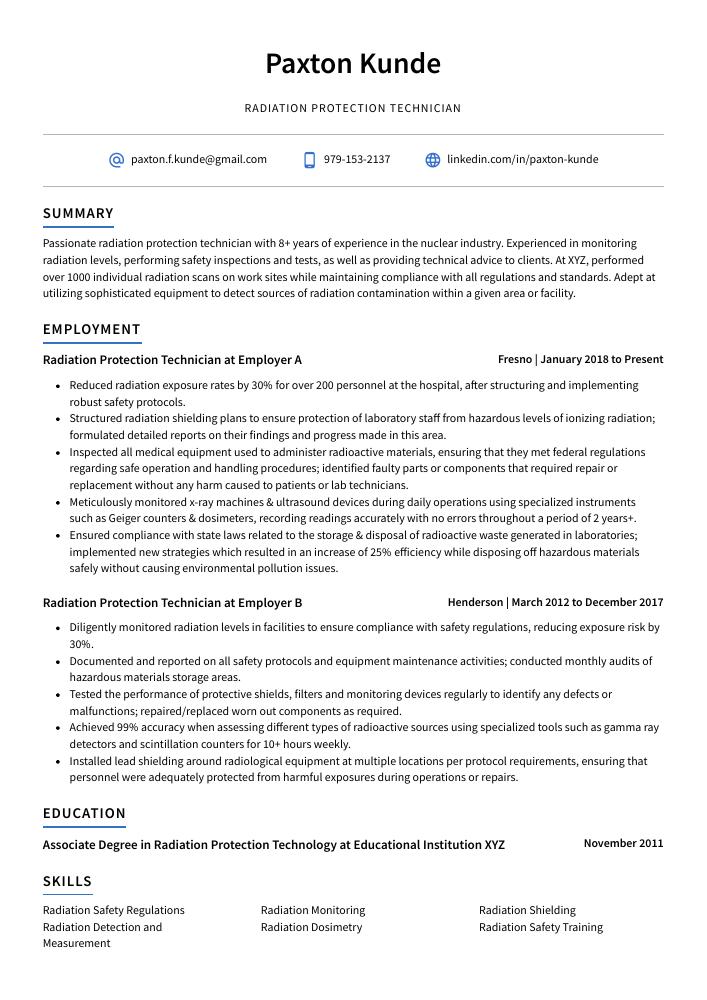Radiation Protection Technician Resume Guide
Radiation protection technicians monitor and control radiation levels to ensure safety in a variety of settings. They inspect, maintain, and operate equipment used for radiation monitoring as well as perform surveys to assess the potential hazards associated with exposure to radioactive materials. Additionally, they provide guidance on proper safety procedures related to radiation use and disposal.
Your expertise in radiation protection and safety is unparalleled, yet no one knows who you are. To draw attention to your qualifications and experience, you must create a resume that stands out from the crowd.
This guide will walk you through the entire process of creating a top-notch resume. We first show you a complete example and then break down what each resume section should look like.
Table of Contents
The guide is divided into sections for your convenience. You can read it from beginning to end or use the table of contents below to jump to a specific part.
Radiation Protection Technician Resume Sample
Paxton Kunde
Radiation Protection Technician
[email protected]
979-153-2137
linkedin.com/in/paxton-kunde
Summary
Passionate radiation protection technician with 8+ years of experience in the nuclear industry. Experienced in monitoring radiation levels, performing safety inspections and tests, as well as providing technical advice to clients. At XYZ, performed over 1000 individual radiation scans on work sites while maintaining compliance with all regulations and standards. Adept at utilizing sophisticated equipment to detect sources of radiation contamination within a given area or facility.
Experience
Radiation Protection Technician, Employer A
Fresno, Jan 2018 – Present
- Reduced radiation exposure rates by 30% for over 200 personnel at the hospital, after structuring and implementing robust safety protocols.
- Structured radiation shielding plans to ensure protection of laboratory staff from hazardous levels of ionizing radiation; formulated detailed reports on their findings and progress made in this area.
- Inspected all medical equipment used to administer radioactive materials, ensuring that they met federal regulations regarding safe operation and handling procedures; identified faulty parts or components that required repair or replacement without any harm caused to patients or lab technicians.
- Meticulously monitored x-ray machines & ultrasound devices during daily operations using specialized instruments such as Geiger counters & dosimeters, recording readings accurately with no errors throughout a period of 2 years+.
- Ensured compliance with state laws related to the storage & disposal of radioactive waste generated in laboratories; implemented new strategies which resulted in an increase of 25% efficiency while disposing off hazardous materials safely without causing environmental pollution issues.
Radiation Protection Technician, Employer B
Henderson, Mar 2012 – Dec 2017
- Diligently monitored radiation levels in facilities to ensure compliance with safety regulations, reducing exposure risk by 30%.
- Documented and reported on all safety protocols and equipment maintenance activities; conducted monthly audits of hazardous materials storage areas.
- Tested the performance of protective shields, filters and monitoring devices regularly to identify any defects or malfunctions; repaired/replaced worn out components as required.
- Achieved 99% accuracy when assessing different types of radioactive sources using specialized tools such as gamma ray detectors and scintillation counters for 10+ hours weekly.
- Installed lead shielding around radiological equipment at multiple locations per protocol requirements, ensuring that personnel were adequately protected from harmful exposures during operations or repairs.
Skills
- Radiation Safety Regulations
- Radiation Monitoring
- Radiation Shielding
- Radiation Detection and Measurement
- Radiation Dosimetry
- Radiation Safety Training
- Radiation Protection Equipment Maintenance
- Radiation Decontamination
- Radiation Safety Audits
Education
Associate Degree in Radiation Protection Technology
Educational Institution XYZ
Nov 2011
Certifications
Radiation Protection Technician Certification
American Board of Radiology
May 2017
1. Summary / Objective
Your resume summary should be a brief yet compelling overview of your qualifications as a radiation protection technician. Include details such as the number of years you have been working in this field, any certifications or licenses you possess, and how your expertise has helped to ensure safety protocols are followed correctly. You could also mention that you have experience with various types of equipment used for radiation detection and monitoring.
Below are some resume summary examples:
Hard-working radiation protection technician with 5+ years of experience in radiation safety and environmental health. Skilled at monitoring occupational exposures, providing technical advice on contamination control and decontamination techniques, conducting dosimetry surveys, and ensuring compliance with regulations. Seeking to join ABC Inc. as the Radiation Protection Technician to ensure safe working conditions for employees while maximizing efficiency.
Seasoned radiation protection technician with 10+ years of experience working in industrial and medical environments. Proven track record of ensuring compliance with regulations, analyzing radiation levels, providing safety training to personnel, and conducting emergency response protocols when needed. Seeking a challenging opportunity at ABC Corp where I can leverage my expertise to help protect workers from the risks associated with hazardous materials.
Amicable radiation protection technician with ten years of experience providing radiation safety services to clients in the healthcare and nuclear industries. Recognized for outstanding performance, including leading a team that reduced patient exposure by 20%. Experienced in developing safety protocols, monitoring radiation levels, and troubleshooting equipment problems. Committed to upholding high standards of quality control and customer satisfaction.
Skilled radiation protection technician with 10+ years of experience in radiation safety and monitoring to protect personnel, equipment, and the environment. Seeking a position at ABC Company where I can leverage my knowledge of radiological hazards to ensure that operations are performed safely. Proven track record for accurate measurements, sound judgment on technical decisions, and consistent practice of regulatory requirements.
Driven radiation protection technician with five years of experience in the health care field. At XYZ, designed and implemented radiation safety protocols for medical staff to protect them from exposure. Demonstrated expertise in using a variety of detection devices to measure radioactive contamination levels. Developed effective strategies for safe storage and disposal of hazardous materials according to state regulations.
Proficient radiation protection technician with 5+ years of experience in radiation safety and compliance. At XYZ, served as the lead technician on 20 projects for clients requiring radiation monitoring services. Received high praise from customers for accuracy, attention to detail, and ability to stay within budget requirements. Certified by the National Academy of Nuclear Training in Radiation Protection (NANTRP).
Committed radiation protection technician with 4+ years of experience monitoring radiation levels, conducting safety inspections and audits, and preparing reports. Proven ability to collaborate successfully with engineering teams to ensure compliance and reduce health risks. Seeking a role at ABC Tech where I can apply my expertise in radiation safety protocols while developing new skills.
Determined radiation protection technician with 5+ years of experience managing radiation safety programs at two major medical centers. Committed to ensuring compliance with Nuclear Regulatory Commission regulations and mitigating potential risks in clinical settings. Seeking to leverage expertise and knowledge of radiation safety protocols for ABC Hospital’s radiology department.
2. Experience / Employment
Next comes the work history section, which should be written in reverse chronological order. This means your most recent job is listed first.
When writing about what you did, it’s best to stick with bullet points for clarity and ease of reading. You want to provide detail on the tasks performed and the results achieved; avoid general statements as much as possible.
For example, instead of saying “Monitored radiation levels,” you could say, “Conducted daily checks using a Geiger counter to ensure that radiation exposure remained within acceptable limits.”
To write effective bullet points, begin with a strong verb or adverb. Industry specific verbs to use are:
- Monitored
- Inspected
- Calibrated
- Assessed
- Evaluated
- Operated
- Recorded
- Analyzed
- Tested
- Implemented
- Installed
- Shielded
- Contained
- Disposed
- Documented
Other general verbs you can use are:
- Achieved
- Advised
- Compiled
- Coordinated
- Demonstrated
- Developed
- Expedited
- Facilitated
- Formulated
- Improved
- Introduced
- Mentored
- Optimized
- Participated
- Prepared
- Presented
- Reduced
- Reorganized
- Represented
- Revised
- Spearheaded
- Streamlined
- Structured
- Utilized
Below are some example bullet points:
- Improved radiation shielding in the workspace by 30% through regular testing and maintenance of protective equipment.
- Prepared detailed radiation protection plans for 200+ X-ray procedures, taking into account all safety regulations to ensure proper protocols were followed.
- Proficiently operated a variety of radiometric instruments such as dose rate meters and energy spectrometers, along with other specialized tools used to measure gamma radiation levels in the environment.
- Facilitated daily inspections for over 600 pieces of radiological equipment; detected potential malfunctions before they occurred on 60 occasions during this period, resulting in significant cost savings for the organization due to reduced downtime & repairs costs.
- Compiled monthly reports detailing current trends related to environmental radiation exposure across various workplaces within the company’s network; identified areas requiring higher standards of compliance and submitted recommendations accordingly.
- Effectively calibrated and maintained radiation protection equipment in accordance with safety protocols, ensuring the safe operation of medical imaging machines and reducing patient exposure by 20%.
- Advised radiologists on proper use of protective gear during procedures; provided additional training sessions to educate staff on how to protect against ionizing radiation.
- Assessed worksites for potential hazards related to occupational exposure; identified high levels of hazardous contamination in laboratory areas, leading to successful removal from service until further decontamination was complete.
- Represented the company at various conferences regarding health regulations & standards pertaining to radiation protection measures throughout the healthcare industry; successfully presented latest research findings at a major healthcare conference attended by over 300 delegates from across North America.
- Monitored employee records & compliance reports regularly, verifying that all personnel had up-to-date certification/training as required by law before being allowed access into any radioactive zones or facilities containing radioactive materials; reduced noncompliance incidents by 30% within one year’s time frame.
- Operated radiation monitoring instruments to detect and measure radiation levels in the environment, ensuring compliance with safety standards and regulations; successfully completed 400+ tests per month.
- Developed new protocols related to radiation protection procedures while collaborating closely with other technicians, supervisors & engineers on hazardous waste management plans.
- Analyzed data from various equipment readings and provided detailed reports of findings; identified & addressed deficiencies that resulted in a 15% decrease in exposed personnel incidents over 3 months time period.
- Accurately computed exposure rate values for radioactive sources using complex mathematical equations; calculated results within 4 minutes per sample with an average error margin of 0%.
- Evaluated laboratory conditions regularly by measuring airborne contamination levels, identifying potential risks & suggesting corrective measures to reduce workers’ exposures accordingly.
- Monitored radiation levels in the workplace daily, ensuring that they did not exceed safety standards and regulations; reduced radiation exposure by 20% among employees over a 12-month period.
- Independently developed written procedures to ensure compliance with all applicable regulatory requirements related to radiation protection.
- Demonstrated great attention to detail when conducting inspections of tools, equipment and protective gear used at job sites for potential contamination risks; identified 33 hazards before any damage was done.
- Participated in weekly team meetings with other Radiation Protection Technicians throughout the region to share best practices and coordinate efforts on new projects; contributed positively towards reducing overall radiation incidents by 10%.
- Revised existing protocols for managing radioactive materials, successfully introducing new technologies which enabled more accurate readings of background ambient dose rates within 15 minutes or less per sample collected from site locations in remote areas around the state/country.
- Mentored and trained 5 new radiation protection technicians, ensuring the proper implementation of safety protocols and generating annual savings of $20,000 in personnel costs.
- Expedited the calibration process for 24 medical imaging systems by developing a streamlined procedure; increased accuracy ratings by 30%.
- Recorded dosimetry readings on an ongoing basis to measure staff exposure levels within regulatory limits while also working with individual departments to set up customized protocols as needed.
- Successfully contained 15 radiological incidents through effective implementation of emergency response plans and procedures; reduced contamination spread by 100%.
- Monitored radiation levels around 10 construction sites daily for potential hazards or breaches before providing necessary recommendations to clients on risk management strategies and safe handling techniques.
- Optimized the radiation protection measures of a medical facility by testing and calibrating X-ray machines, ensuring that all equipment was operating within established safety regulations.
- Utilized sophisticated monitoring systems to record real-time readings of the total number of rads generated; reduced radiation exposure levels among staff members by 30%.
- Confidently identified and resolved malfunctions in medical imaging devices while maintaining records on all maintenance activities performed; cut down repair costs by 25%.
- Spearheaded the installation of new radiation shielding materials such as lead aprons, using advanced tools and techniques for safe handling procedures; boosted efficiency rates by 10% over 6 months.
- Implemented comprehensive training programs for healthcare professionals regarding proper use & care of radiography equipment, resulting in improved patient safety outcomes at the facility overall.
- Streamlined radiation protection processes across multiple departments, resulting in a 30% increase in operational efficiency.
- Coordinated with nuclear plant personnel to ensure that radiation safety standards and protocols were strictly adhered to at all times; led trainings for new staff on proper handling of radioactive materials.
- Presented research findings before the Nuclear Regulatory Commission (NRC), advocating for more stringent regulations and safeguards against potential health risks associated with radiation exposure; helped revise current legislation accordingly.
- Actively monitored levels of ionizing radiations within workplaces using specialized equipment including Geiger counters, thermoluminescence detectors and dosimeters; identified high-risk areas where additional protective measures had to be taken immediately.
- Introduced innovative strategies such as lead shielding, remote monitoring systems & automatic shutoff mechanisms which significantly reduced occupational hazard incidents by 40%.
- Disposed of radioactive materials and waste accurately and safely, adhering to all safety protocols while reducing contamination by 10%.
- Reorganized the radiation protection lab to improve workflow efficiency; developed a new protocol for handling radioactive samples that saved 5 hours per week in laboratory time.
- Thoroughly inspected equipment for any signs of deterioration or malfunction before each use; successfully identified 3 faulty machines which were subsequently replaced with new ones resulting in improved accuracy of measurements taken.
- Shielded both personnel and patients from excessive radiation exposure through the proper installation, calibration & maintenance of protective shields, leading to an overall reduction in health risks posed by tests performed at the facility by 20%.
3. Skills
The skillset employers require in an employee will likely vary, either slightly or significantly; skimming through their job adverts is the best way to determine what each is looking for. One organization might require the candidate to be knowledgeable in radiation safety protocols, while another might prefer someone with experience using a Geiger counter.
It is important to customize your resume for each job you apply for; this includes tailoring the skills section of your resume to reflect what that particular employer wants from their ideal employee. This will help ensure that companies’ applicant tracking systems pick up on certain keywords and pass through your application accordingly.
In addition, it’s also beneficial to discuss these skills further within other sections of the resume such as summary or work experience – this gives employers an insight into how well-versed you are in those areas and why they should hire you over others.
Below is a list of common skills & terms:
- Radiation Decontamination
- Radiation Detection and Measurement
- Radiation Dosimetry
- Radiation Monitoring
- Radiation Protection Equipment Maintenance
- Radiation Safety Audits
- Radiation Safety Program Management
- Radiation Safety Regulations
- Radiation Safety Training
- Radiation Shielding
4. Education
Mentioning an education section on your resume will depend on how far along you are in your career. If you just graduated and have no prior work experience, include this information below your resume objective. However, if you have significant work experience to showcase, it might be best to omit the education section altogether.
If an education section is included, try to mention courses and subjects related to radiation protection technician that demonstrate a commitment or understanding of the role for which you are applying.
Associate Degree in Radiation Protection Technology
Educational Institution XYZ
Nov 2011
5. Certifications
Certifications are a great way to demonstrate your expertise in a particular field. They are also an excellent indicator of professional development, as they show that you have kept up with industry trends and standards.
When applying for jobs, it is important to include any certifications relevant to the position on your resume. This will help employers quickly identify if you possess the skills necessary for the job and can be beneficial when competing against other applicants who may not have such qualifications.
Radiation Protection Technician Certification
American Board of Radiology
May 2017
6. Contact Info
Your name should be the first thing a reader sees when viewing your resume, so ensure its positioning is prominent. Your phone number should be written in the most commonly used format in your country/city/state, and your email address should be professional.
You can also choose to include a link to your LinkedIn profile, personal website, or other online platforms relevant to your industry.
Finally, name your resume file appropriately to help hiring managers; for Paxton Kunde, this would be Paxton-Kunde-resume.pdf or Paxton-Kunde-resume.docx.
7. Cover Letter
Attaching a cover letter to your job application is a great way to introduce yourself and express why you’re the best candidate for the role. It should be made up of 2-4 succinct paragraphs, providing more detail than what can fit on a resume.
Cover letters are not always necessary but it’s highly recommended that you include one with your application. This will give hiring managers further insight into who you are as an individual and professional and help them make their decision about whether or not to move forward in the recruitment process.
Below is an example cover letter:
Dear Kyle,
I am writing to apply for the Radiation Protection Technician position at [company name]. I am a certified radiation protection technician with more than 10 years of experience working in nuclear power plants and other environments where radioactive materials are present. In my previous role, I was responsible for conducting radiological surveys, monitoring employee exposure to radiation, and maintaining records of radioactivity levels.
I am familiar with all aspects of radiation safety and have a strong understanding of the potential risks associated with exposure to radioactive materials. I am also experienced in developing and implementing safety protocols to protect workers from unnecessary exposure. In my previous role, I developed and implemented a new system for tracking employee exposures that reduced the overall dose by 30%.
I am knowledgeable about various types of radiological equipment and how to properly maintain it. I am also familiar with computerized systems used to monitor radiation levels and track employee exposures. My attention to detail ensures that all data is accurately recorded and that any potential problems are quickly identified and addressed.
I am confident that my skills and experience make me the ideal candidate for this position. I look forward to speaking with you soon about this opportunity. Thank you for your time!
Sincerely,
Paxton
Radiation Protection Technician Resume Templates
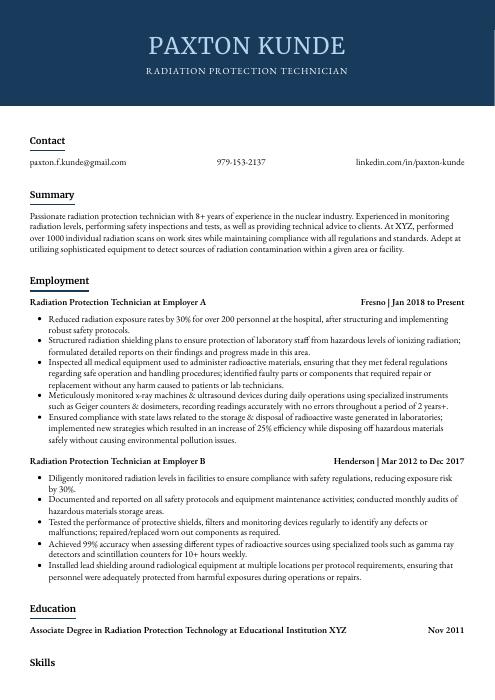 Bonobo
Bonobo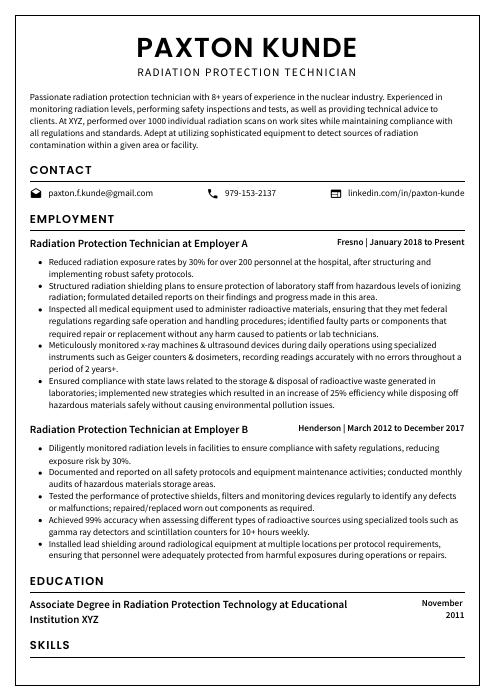 Cormorant
Cormorant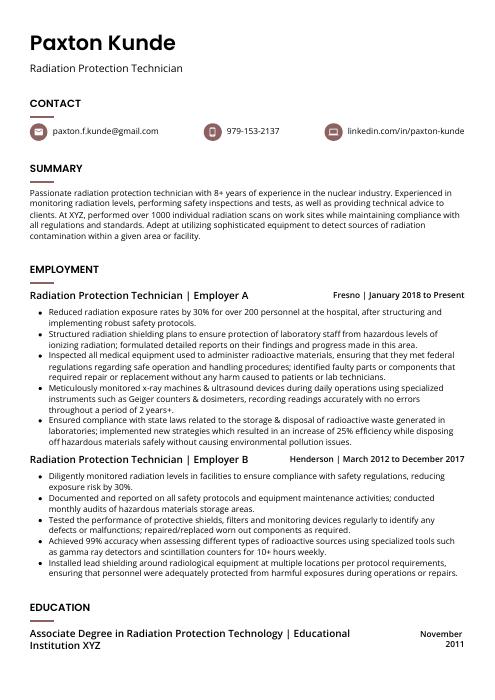 Fossa
Fossa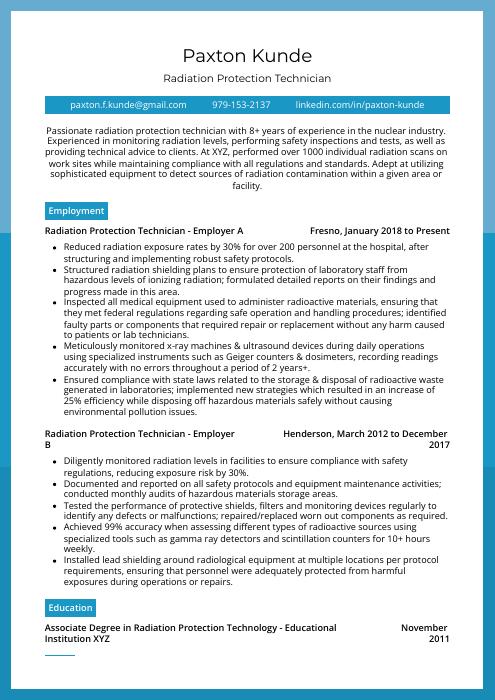 Rhea
Rhea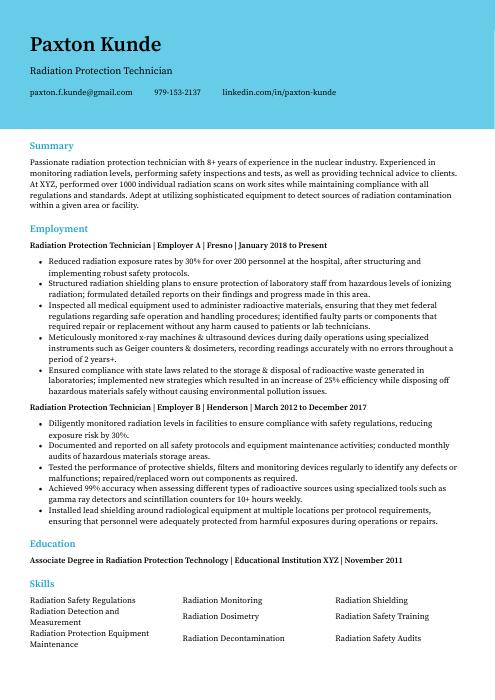 Dugong
Dugong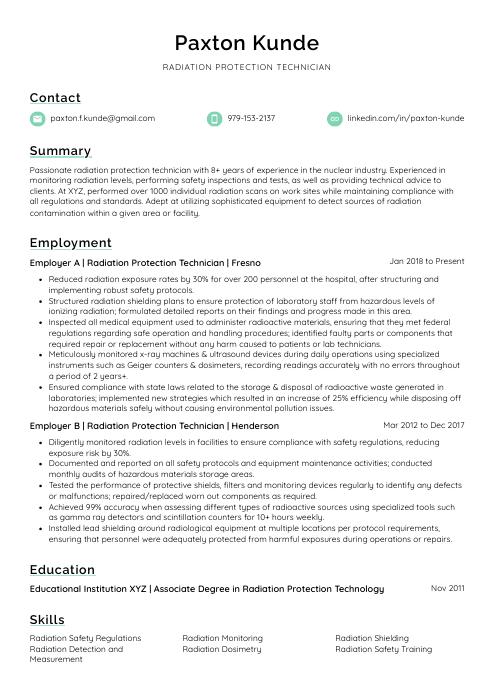 Lorikeet
Lorikeet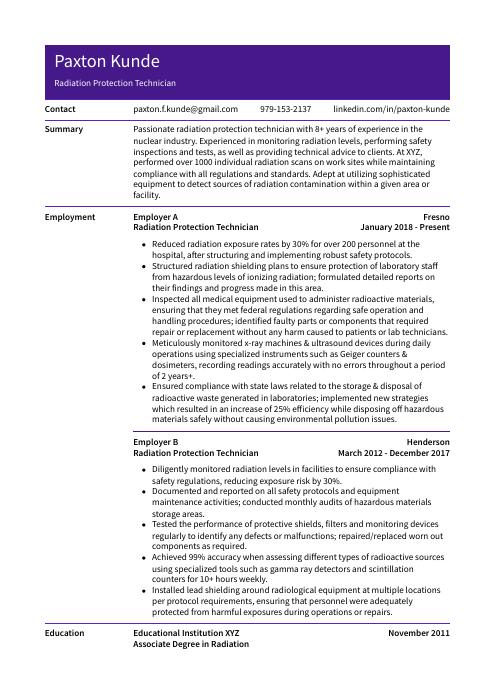 Pika
Pika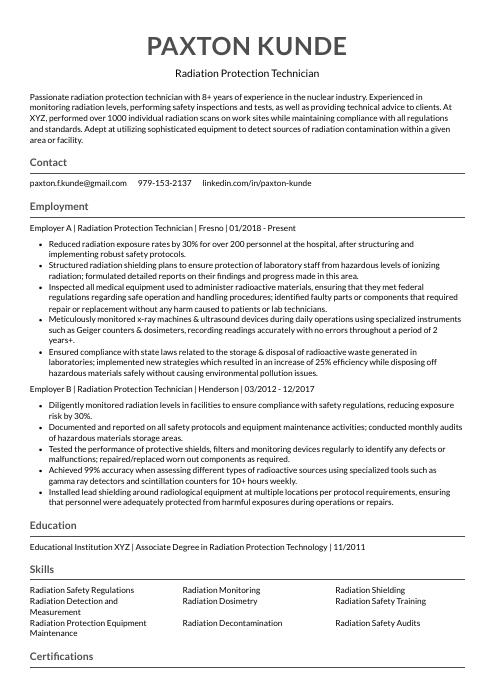 Indri
Indri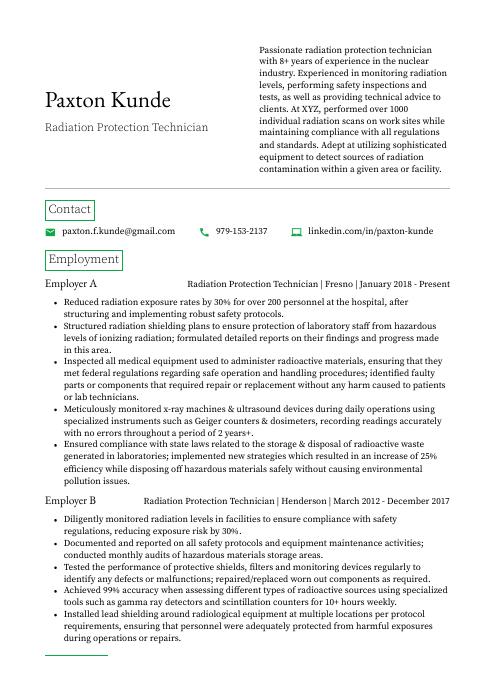 Quokka
Quokka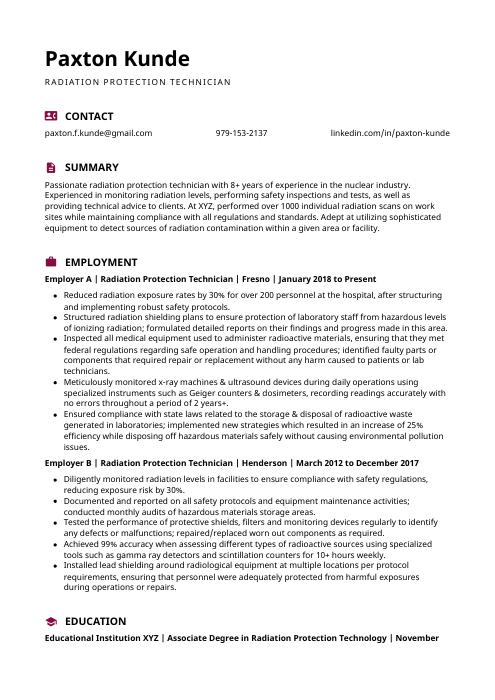 Hoopoe
Hoopoe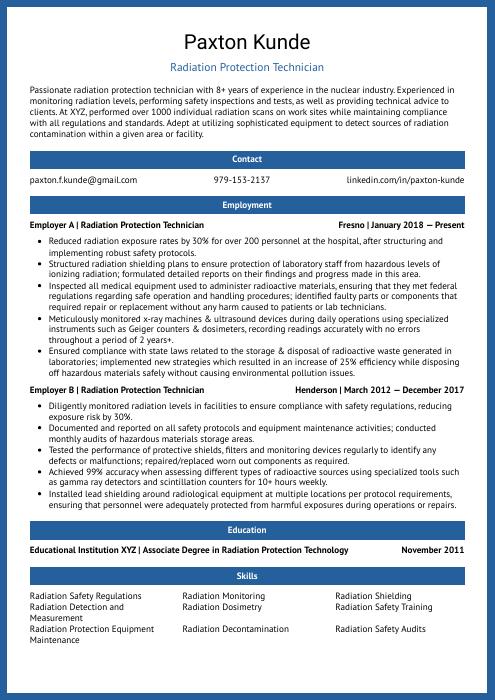 Ocelot
Ocelot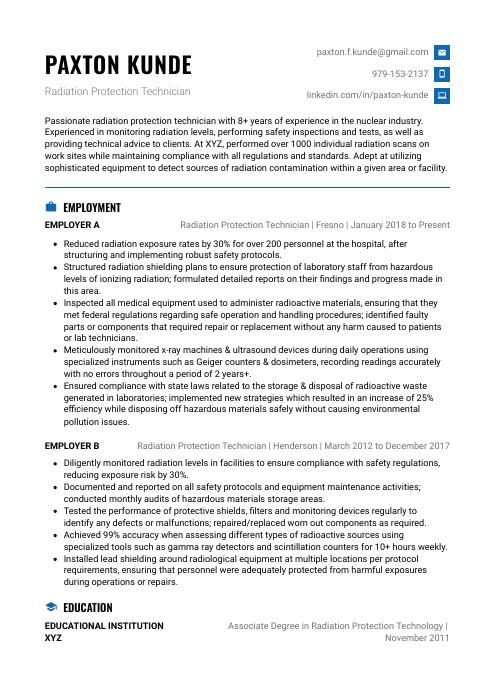 Echidna
Echidna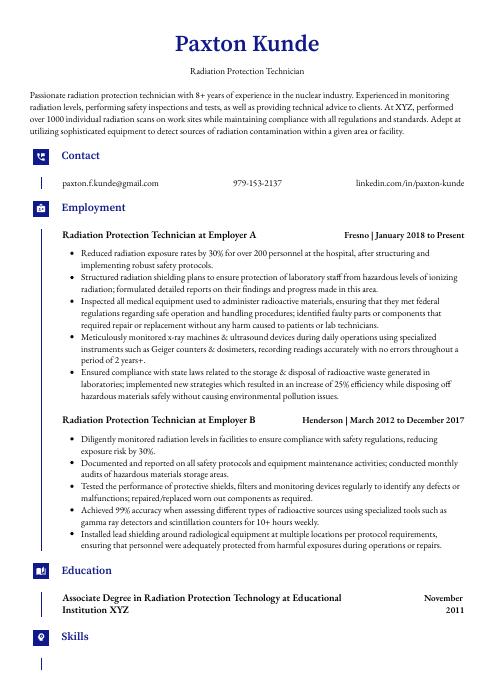 Gharial
Gharial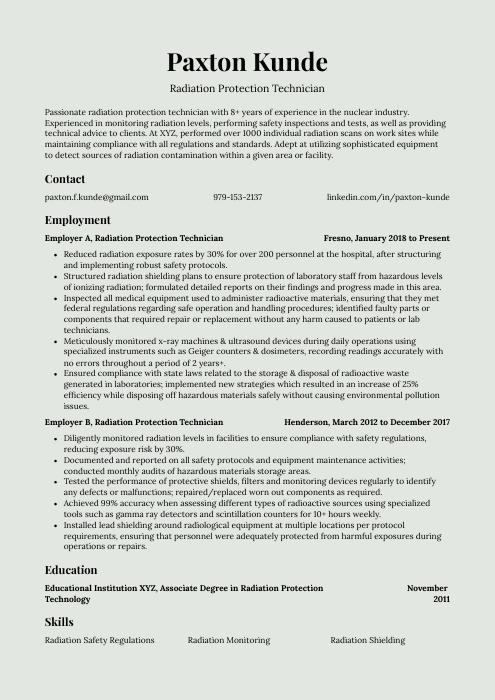 Saola
Saola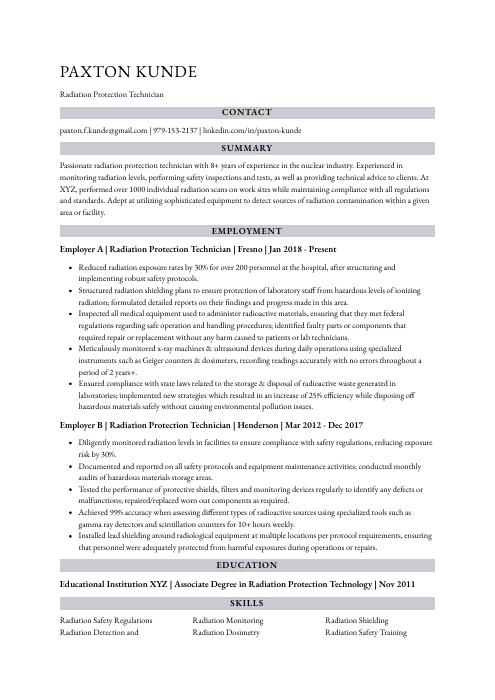 Numbat
Numbat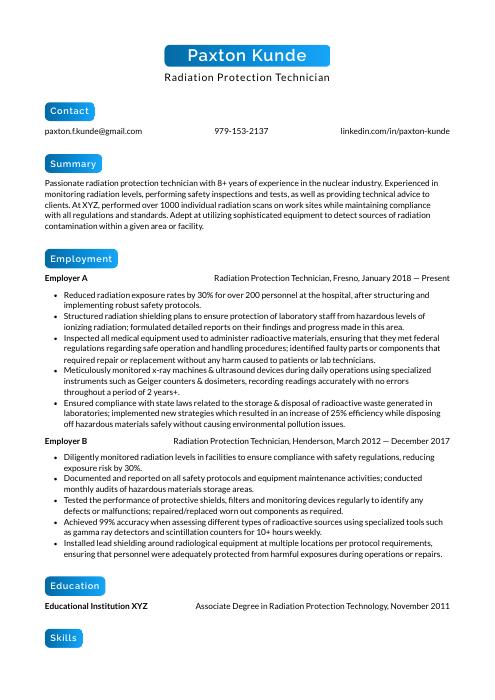 Kinkajou
Kinkajou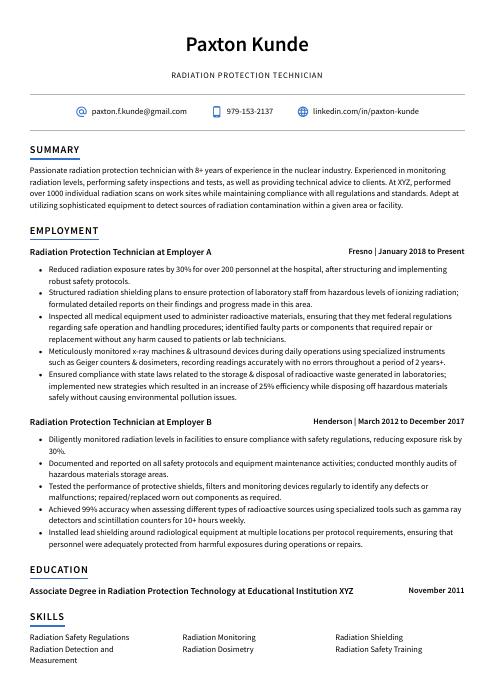 Axolotl
Axolotl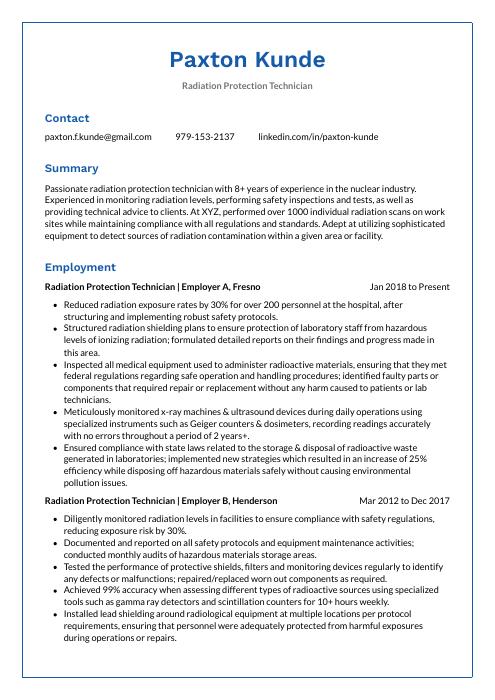 Markhor
Markhor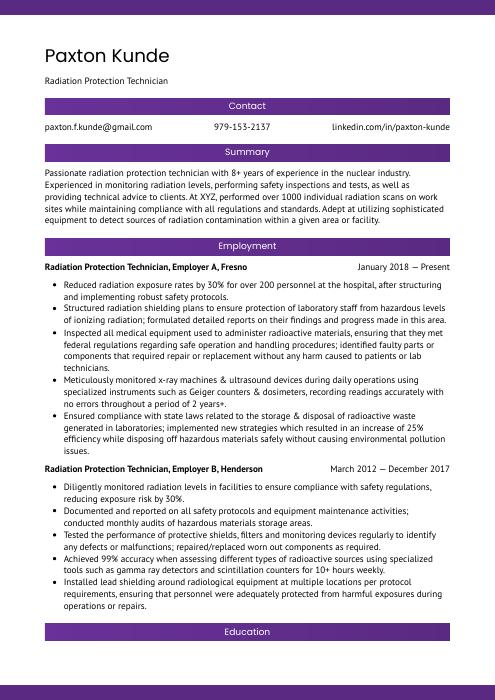 Jerboa
Jerboa Rezjumei
Rezjumei
